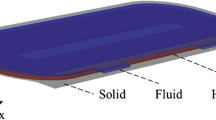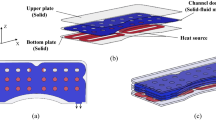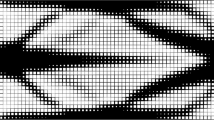Abstract
With the increasing dissipated power levels of electronic equipment, heat sink design problems are significant aspects of some industrial design fields. Topology optimization theory has attracted much research interest in thermal-fluid problems to design high-performance heat sinks. These researches focus on optimizing the internal flow channel of heat sinks under predefined inlet and outlet schemes. However, inlet/outlet schemes also exhibit great influence on the performance of optimized heat sinks. This paper intends to demonstrate a concurrent optimization method of the internal flow channel, inlets, and outlets in forced convection heat sinks. The porosity field and moving morphable components (MMCs) are adopted to describe structural topologies of the internal channel design domain and the inlet/outlet design domains, respectively. The internal porosity field and the shape/position parameters of MMCs are applied as design variables. A conventional inlet/outlet component is presented and the corresponding topology description transformation function is constructed to convert the inlet/outlet topology into corresponding porosity fields. Further, the thermal-fluid coupling problems are solved through porosity-interpolated fluid flow and heat transfer governing equations. To ensure accurate inlet flow and temperature conditions during the topology iteration, continuous design-dependent inlet governing equations are established under inlet pressure, velocity, and flow flux boundary conditions. Design variables are concurrently optimized based on the sensitivity information. The proposed method is shown in detail by taking design problems of water-cooled heat sinks as examples. Various numerical examples are presented to validate the applicability and efficiency of this method.
















Similar content being viewed by others
References
Ahmed HE, Ahmed MI (2015) Optimum thermal design of triangular, trapezoidal and rectangular grooved microchannel heat sinks. Int Commun Heat Mass Transf. https://doi.org/10.1016/j.icheatmasstransfer.2015.05.009
Alexandersen J, Aage N, Andreasen CS, Sigmund O (2014) Topology optimisation for natural convection problems. Int J Numer Methods Fluids. https://doi.org/10.1002/fld.3954
Bendsøe MP, Sigmund O(O) (2003) Topology optimization : theory, methods, and applications. Springer
Christen D, Stojadinovic M, Biela J (2017) Energy efficient heat sink design: natural versus forced convection cooling. IEEE Trans Power Electron. https://doi.org/10.1109/TPEL.2016.2640454
Dbouk T (2017) A review about the engineering design of optimal heat transfer systems using topology optimization. Appl Therm Eng
Dede E (2009) Multiphysics topology optimization of heat transfer and fluid flow systems. Proc COMSOL Users Conf
Dede EM (2012) Optimization and design of a multipass branching microchannel heat sink for electronics cooling. J Electron Packag Trans ASME. https://doi.org/10.1115/1.4007159
Dede EM, Joshi SN, Zhou F (2015) Topology optimization, additive layer manufacturing, and experimental testing of an air-cooled heat sink. J Mech Des Trans ASME. https://doi.org/10.1115/1.4030989
Dilgen SB, Dilgen CB, Fuhrman DR et al (2018) Density based topology optimization of turbulent flow heat transfer systems. Struct Multidiscip Optim. https://doi.org/10.1007/s00158-018-1967-6
Fabbri G (2004) Effect of viscous dissipation on the optimization of the heat transfer in internally finned tubes. Int J Heat Mass Transf. https://doi.org/10.1016/j.ijheatmasstransfer.2004.03.007
Garimella SV, Fleischer AS, Murthy JY et al (2008) Thermal challenges in next-generation electronic systems. IEEE Trans Components Packag Technol. https://doi.org/10.1109/TCAPT.2008.2001197
Guo X, Zhang W, Zhang J, Yuan J (2016) Explicit structural topology optimization based on moving morphable components (MMC) with curved skeletons. Comput Methods Appl Mech Eng. https://doi.org/10.1016/j.cma.2016.07.018
Guo X, Zhang W, Zhong W (2014) Doing topology optimization explicitly and geometrically-a new moving morphable components based framework. J Appl Mech Trans ASME. https://doi.org/10.1115/1.4027609
Haertel JHK, Engelbrecht K, Lazarov BS, Sigmund O (2018) Topology optimization of a pseudo 3D thermofluid heat sink model. Int J Heat Mass Transf. https://doi.org/10.1016/j.ijheatmasstransfer.2018.01.078
Jarrett A, Kim IY (2011) Design optimization of electric vehicle battery cooling plates for thermal performance. J Power Sources. https://doi.org/10.1016/j.jpowsour.2011.06.090
Koga AA, Lopes ECC, Villa Nova HF et al (2013) Development of heat sink device by using topology optimization. Int J Heat Mass Transf. https://doi.org/10.1016/j.ijheatmasstransfer.2013.05.007
Kontoleontos EA, Papoutsis-Kiachagias EM, Zymaris AS et al (2013) Adjoint-based constrained topology optimization for viscous flows, including heat transfer. Eng Optim. https://doi.org/10.1080/0305215X.2012.717074
Lazarov BS, Sigmund O (2011) Filters in topology optimization based on Helmholtz-type differential equations. Int J Numer Methods Eng. https://doi.org/10.1002/nme.3072
Lin PT, Chang C-J, Huang H, Zheng B (2011) Design of cooling system for electronic devices using impinging jets. In: COMSOL Conference. Boston, MA
Manzan M, Nobile E, Pieri S, Pinto F (2008) Multi-objective optimization for problems involving convective heat transfer. In: Optimization and Computational Fluid Dynamics
Marck G, Nemer M, Harion JL (2013) Topology optimization of heat and mass transfer problems: laminar flow. Numer Heat Transf B Fundam. https://doi.org/10.1080/10407790.2013.772001
Matsumori T, Kondoh T, Kawamoto A, Nomura T (2013) Topology optimization for fluid-thermal interaction problems under constant input power. Struct Multidiscip Optim. https://doi.org/10.1007/s00158-013-0887-8
McGlen RJ, Jachuck R, Lin S (2004) Integrated thermal management techniques for high power electronic devices. In: Applied Thermal Engineering
Mitropoulou CC, Fourkiotis Y, Lagaros ND, Karlaftis MG (2013) Evolution strategies-based metaheuristics in structural design optimization. In: Metaheuristic Applications in Structures and Infrastructures
Moore AL, Shi L (2014) Emerging challenges and materials for thermal management of electronics. Mater Today 17:163–174
Olesen LH, Okkels F, Bruus H (2006) A high-level programming-language implementation of topology optimization applied to steady-state Navier-Stokes flow. Int J Numer Methods Eng. https://doi.org/10.1002/nme.1468
Qian S, Wang W, Ge C et al (2018) Topology optimization of fluid flow channel in cold plate for active phased array antenna. Struct Multidiscip Optim. https://doi.org/10.1007/s00158-017-1852-8
Scholten TC (2017) A practical application of topology optimization for heat transfer and fluid dynamics. Dissertation, Delft University of Technology
Sigmund O, Maute K (2013) Topology optimization approaches: a comparative review. Struct Multidiscip Optim 48:1031–1055. https://doi.org/10.1007/s00158-013-0978-6
Sigmund O, Petersson J (1998) Numerical instabilities in topology optimization: a survey on procedures dealing with checkerboards, mesh-dependencies and local minima. Struct Optim. https://doi.org/10.1007/BF01214002
Stolpe M, Svanberg K (2001) An alternative interpolation scheme for minimum compliance topology optimization. Struct Multidiscip Optim. https://doi.org/10.1007/s001580100129
Svanberg K (1987) The method of moving asymptotes—a new method for structural optimization. Int J Numer Methods Eng. https://doi.org/10.1002/nme.1620240207
Tan MHY, Najafi AR, Pety SJ et al (2016) Gradient-based design of actively-cooled microvascular composite panels. Int J Heat Mass Transf. https://doi.org/10.1016/j.ijheatmasstransfer.2016.07.092
Wan Z, Xu L, Zhang Y, et al (2011) Thermal analysis and improvement of high power electronic packages. In: ICEPT-HDP 2011 Proceedings - 2011 International Conference on Electronic Packaging Technology and High Density Packaging
Wang F, Lazarov BS, Sigmund O (2011) On projection methods, convergence and robust formulations in topology optimization. Struct Multidiscip Optim. https://doi.org/10.1007/s00158-010-0602-y
Xu S (2011) The design of new radiator in electronic device. In: Lecture notes in electrical engineering. Springer, Berlin, Heidelberg, pp 505–510
Yaji K, Ogino M, Chen C, Fujita K (2018) Large-scale topology optimization incorporating local-in-time adjoint-based method for unsteady thermal-fluid problem. Struct Multidiscip Optim. https://doi.org/10.1007/s00158-018-1922-6
Yaji K, Yamada T, Kubo S et al (2015) A topology optimization method for a coupled thermal-fluid problem using level set boundary expressions. Int J Heat Mass Transf. https://doi.org/10.1016/j.ijheatmasstransfer.2014.11.005
Yenigun O, Cetkin E (2016) Experimental and numerical investigation of constructal vascular channels for self-cooling: parallel channels, tree-shaped and hybrid designs. Int J Heat Mass Transf. https://doi.org/10.1016/j.ijheatmasstransfer.2016.08.074
Yoon GH (2010) Topological design of heat dissipating structure with forced convective heat transfer. J Mech Sci Technol. https://doi.org/10.1007/s12206-010-0328-1
Yu M, Ruan S, Wang X et al (2019) Topology optimization of thermal–fluid problem using the MMC-based approach. Struct Multidiscip Optim. https://doi.org/10.1007/s00158-019-02206-w
Zeng S, Kanargi B, Lee PS (2018) Experimental and numerical investigation of a mini channel forced air heat sink designed by topology optimization. Int J Heat Mass Transf. https://doi.org/10.1016/j.ijheatmasstransfer.2018.01.039
Zhao X, Zhou M, Liu Y et al (2019) Topology optimization of channel cooling structures considering thermomechanical behavior. Struct Multidiscip Optim. https://doi.org/10.1007/s00158-018-2087-z
Zhao X, Zhou M, Sigmund O, Andreasen CS (2018) A “poor man’s approach” to topology optimization of cooling channels based on a Darcy flow model. Int J Heat Mass Transf. https://doi.org/10.1016/j.ijheatmasstransfer.2017.09.090
Acknowledgements
The author thanks Prof. Krister Svanberg for use of the MMA optimizer.
Funding
This work was supported in part by the National Natural Science Foundation of China under Grant 51677104.
Author information
Authors and Affiliations
Corresponding author
Ethics declarations
Conflict of interest
The authors declare that they have no conflict of interest.
Replication of results
The authors have attempted to explain the method and implementation issues in detail. All numerical examples are implemented with homemade MATLAB codes and COMSOL documents. Basic MATLAB codes and the results datasets can be available only for academic use from the corresponding author on reasonable request. The COMSOL documents are modified from open documents in Haertel’s work (2018).
Additional information
Responsible Editor: Nestor V Queipo
Publisher’s note
Springer Nature remains neutral with regard to jurisdictional claims in published maps and institutional affiliations.
Rights and permissions
About this article
Cite this article
Zhao, J., Zhang, M., Zhu, Y. et al. Concurrent optimization of the internal flow channel, inlets, and outlets in forced convection heat sinks. Struct Multidisc Optim 63, 121–136 (2021). https://doi.org/10.1007/s00158-020-02670-9
Received:
Revised:
Accepted:
Published:
Issue Date:
DOI: https://doi.org/10.1007/s00158-020-02670-9




